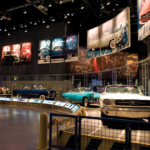TOKYO, Japan, October 29, 2025 – Honda Motor Co., Ltd. today held the Honda Automotive Technology Workshop for members of news media. Following is a summary of the next-generation technologies for automobile products scheduled to go on sale in the second half of the 2020s.
Key technologies introduced at the workshop included: 1) the platform for next-generation hybrid models, 2) hybrid-electric system technologies for new large-size hybrid models scheduled to be launched in North America in the second half of the 2020s, and 3) key technologies to be applied to the production model of a compact EV based on the Super-ONE Prototype, which made its world debut at the Japan Mobility Show 2025.
Honda positions the “environment” and “safety” as priority issues that need to be addressed in order for Honda to continue offering the joy and freedom of mobility to people in a sustainable manner. Based on this belief, Honda has set ambitious goals of achieving “carbon neutrality for all of its products and corporate activities” and “zero fatalities from traffic collisions involving Honda motorcycles and automobiles,” globally by 2050.
As announced at the 2025 Honda Business Briefing held in May of this year, Honda is working to further strengthen the competitiveness of its electric vehicles (EV) and hybrid-electric vehicles (HEV) and offer new value to customers through electrification and enhanced application of intelligent technologies.
In the meantime, Honda will continue to pursue its value proposition in the electrified era: the “joy of driving” experienced by the driver while driving with a sense of oneness with their vehicle. Regardless of powertrain type, EV or HEV, Honda will continue to build its products based on the Honda M/M Concept*1, a human-centric approach to Honda car design, and pursue the “joy of driving,” offering comfort and fun not only to the driver but to all occupants.
Under the concept of “Enjoy the Drive” which represents the value proposition of Honda automobile products, which is centered on the M/M Concept and the “joy of driving,” Honda will remain committed to making steady advancements of next-generation automotive technologies. At the workshop, Honda unveiled new technologies being developed to embody the unique approach and value system of Honda.
Honda is further advancing all aspects of its hybrid system and the HEV platform, with a plan to start adopting them from a group of next-generation HEV models to be introduced to market from 2027 onward.
The next-generation platform is being developed by combining various innovative technologies to realize both high body rigidity and lightweight at a high level and a modular architecture that enables greater parts commonality. This will further enhance the “joy of driving” unique only to Honda, enabling the driver to enjoy a sporty and exhilarating driving experience.
As market demand for HEV models continues to grow, Honda positions its HEV models, especially the next-generation models scheduled to go on sale in 2027 and beyond, as a core group of products which will play key role during the transitional period leading up to the full-fledged popularization of HEVs.
Especially in the North American market, which will be the main market for HEV models, there will continue to be solid demand for large-size HEVs. To fulfill such demand, Honda is developing a next-generation hybrid system featuring powerful driving performance and high towing capacity, as well as outstanding environmental performance, befitting large-size HEVs in the D-segment and larger, with product launches in the second half of the 2020s.
At this workshop, Honda unveiled key technologies of its next-generation large-size hybrid systems, including a newly developed V6 engine that complies with stringent environmental regulations, as well as newly developed drive units and battery pack that achieve both high efficiency and low cost.
The production model based on the Super-ONE Prototype, which made its world debut at the Japan Mobility Show 2025, is scheduled to go on sale first in Japan in 2026, then in the U.K. and other Asian countries where demand for compact EVs is high*3. With the grand concept defined as “e: Dash BOOSTER,” Honda is aiming to create a compact EV that transforms everyday mobility into an exciting and uplifting experience by offering a variety of features that make the in-vehicle experience more enjoyable for customers.
For the simulated 7-speed transmission, simulated engine speed and gear positions are calculated in real time based on driver inputs such as accelerator operation and driving conditions including vehicle speed and vehicle behavior during cornering. By optimally controlling driving force and response, the driver can enjoy driving while feeling a sense of oneness with the vehicle. Moreover, the simulated 7-speed transmission also simulates the shock of “kickdown” during acceleration and vehicle behavior during the “fuel cut” — temporarily cutting off fuel injection to protect the engine and properly control the engine rpm. Through these effects, Honda has successfully integrated the driving feel Honda has been pursuing through the years of ICE development into its EVs.
With these playful, new technologies developed exclusively for the Super-ONE, Honda will strive to offer the “joy of driving” unique only to Super-ONE, which combines the smooth and linear acceleration feel of EVs and the uplifting driving experience of ICE models.
*1 The “man maximum, machine minimum (M/M)” concept is a basic approach to Honda car design to increase the efficiency of the vehicle interior by maximizing space for people and minimizing the space required for mechanical components.
*2 A technology that controls deceleration G in accordance with steering input to increase the load put on the front wheels, thereby increasing the grip of the front wheels.
*3 The production model is scheduled to be launched under different names depending on the region: Super-ONE in Japan and the Asia & Oceania region; Honda Super-ONE in some of Asia & Oceania countries; Super-N in the U.K. 












